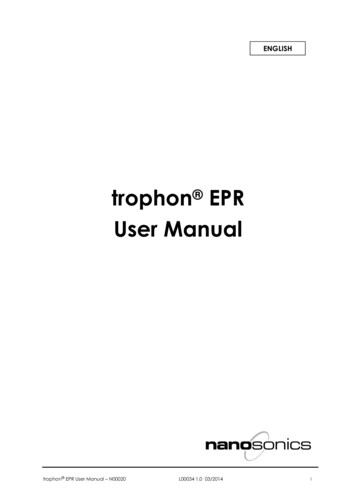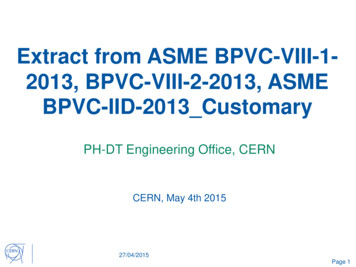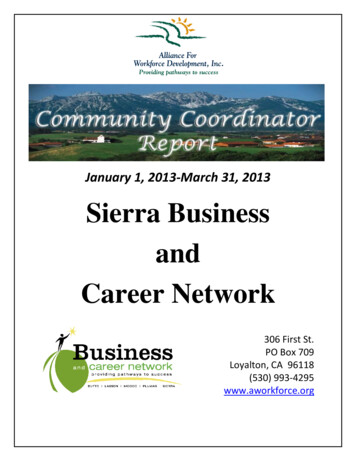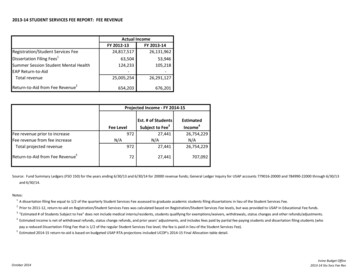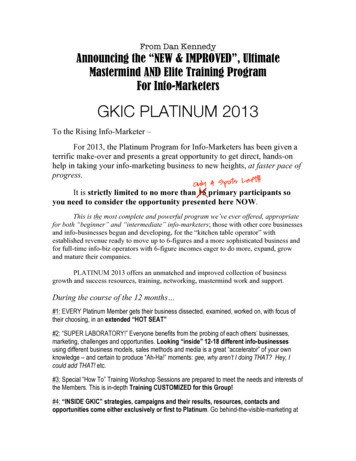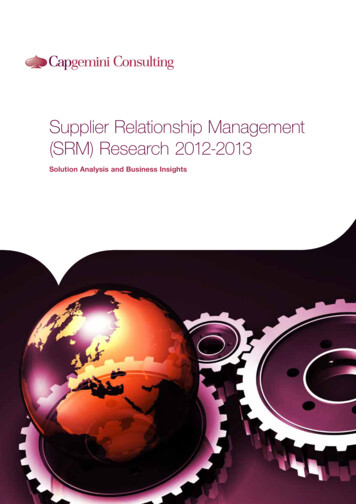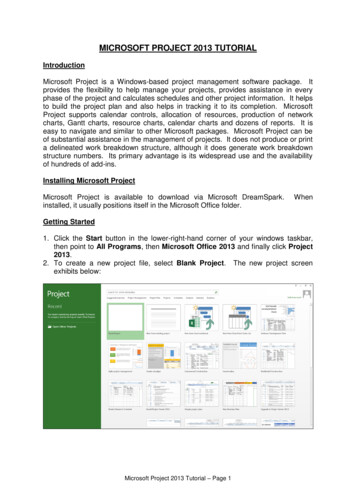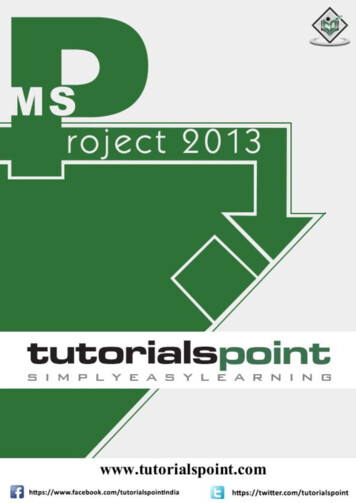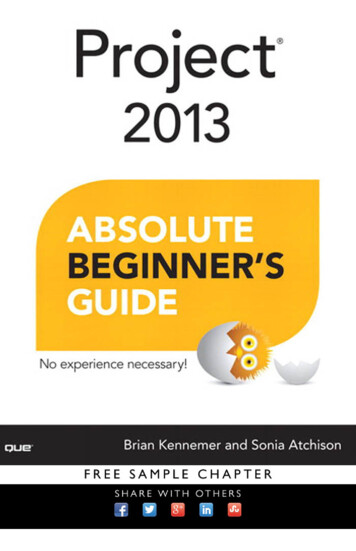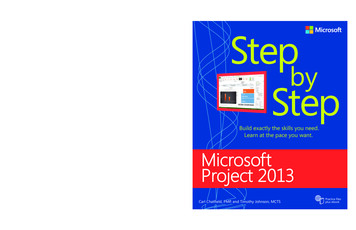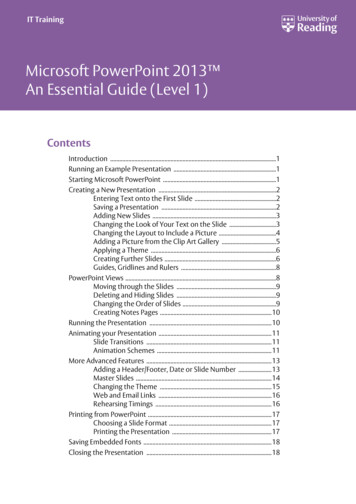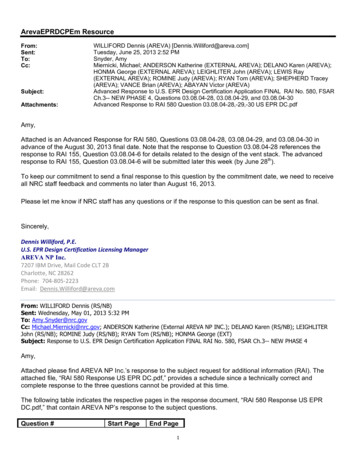
Transcription
ArevaEPRDCPEm ORD Dennis (AREVA) [Dennis.Williford@areva.com]Tuesday, June 25, 2013 2:52 PMSnyder, AmyMiernicki, Michael; ANDERSON Katherine (EXTERNAL AREVA); DELANO Karen (AREVA);HONMA George (EXTERNAL AREVA); LEIGHLITER John (AREVA); LEWIS Ray(EXTERNAL AREVA); ROMINE Judy (AREVA); RYAN Tom (AREVA); SHEPHERD Tracey(AREVA); VANCE Brian (AREVA); ABAYAN Victor (AREVA)Advanced Response to U.S. EPR Design Certification Application FINAL RAI No. 580, FSARCh.3-- NEW PHASE 4, Questions 03.08.04-28, 03.08.04-29, and 03.08.04-30Advanced Response to RAI 580 Question 03.08.04-28,-29,-30 US EPR DC.pdfAmy,Attached is an Advanced Response for RAI 580, Questions 03.08.04-28, 03.08.04-29, and 03.08.04-30 inadvance of the August 30, 2013 final date. Note that the response to Question 03.08.04-28 references theresponse to RAI 155, Question 03.08.04-6 for details related to the design of the vent stack. The advancedresponse to RAI 155, Question 03.08.04-6 will be submitted later this week (by June 28th).To keep our commitment to send a final response to this question by the commitment date, we need to receiveall NRC staff feedback and comments no later than August 16, 2013.Please let me know if NRC staff has any questions or if the response to this question can be sent as final.Sincerely,Dennis Williford, P.E.U.S. EPR Design Certification Licensing ManagerAREVA NP Inc.7207 IBM Drive, Mail Code CLT 2BCharlotte, NC 28262Phone: 704-805-2223Email: Dennis.Williford@areva.comFrom: WILLIFORD Dennis (RS/NB)Sent: Wednesday, May 01, 2013 5:32 PMTo: Amy.Snyder@nrc.govCc: Michael.Miernicki@nrc.gov; ANDERSON Katherine (External AREVA NP INC.); DELANO Karen (RS/NB); LEIGHLITERJohn (RS/NB); ROMINE Judy (RS/NB); RYAN Tom (RS/NB); HONMA George (EXT)Subject: Response to U.S. EPR Design Certification Application FINAL RAI No. 580, FSAR Ch.3-- NEW PHASE 4Amy,Attached please find AREVA NP Inc.’s response to the subject request for additional information (RAI). Theattached file, “RAI 580 Response US EPR DC.pdf,” provides a schedule since a technically correct andcomplete response to the three questions cannot be provided at this time.The following table indicates the respective pages in the response document, “RAI 580 Response US EPRDC.pdf,” that contain AREVA NP’s response to the subject questions.Question #Start PageEnd Page1
RAI 580 — 03.08.04-28RAI 580 — 03.08.04-29RAI 580 — 03.08.04-30246356The schedule for a technically correct and complete response to these questions is provided below.Question #Advanced Response DateRAI 580 — 03.08.04-28RAI 580 — 03.08.04-29RAI 580 — 03.08.04-30June 28, 2013June 28, 2013June 28, 2013NRC CommentRequest DateAugust 16, 2013August 16, 2013August 16, 2013Final Response DateAugust 30, 2013August 30, 2013August 30, 2013Sincerely,Dennis Williford, P.E.U.S. EPR Design Certification Licensing ManagerAREVA NP Inc.7207 IBM Drive, Mail Code CLT 2BCharlotte, NC 28262Phone: 704-805-2223Email: Dennis.Williford@areva.comFrom: Snyder, Amy [mailto:Amy.Snyder@nrc.gov]Sent: Thursday, April 04, 2013 3:56 PMTo: ZZ-DL-A-USEPR-DLCc: Miernicki, Michael; Xu, Jim; Segala, JohnSubject: U.S. EPR Design Certification Application FINAL RAI No. 580, FSAR Ch.3-- NEW PHASE 4Attached please find the subject request for additional information (RAI). Draft RAI was provided to you on March 18,2013. On March 26, 2013, you requested a clarification call. On April 2, 2013, the draft RAI was discussed with yourstaff. As a result of this discussion, the draft RAI was revised and you informed us that with the change the revised RAIis clear and does not contain AREVA Proprietary information. The schedule we have established for review of yourapplication assumes technically correct and complete responses within 30 days of receipt of this Final RAI or by May 6,2013. If this RAI question cannot be answered within 30 days, it is expected that a date for receipt of this information willbe provided to the staff within the 30-day period so that the staff can assess how this information will impact thepublished scheduleThank You,AmyAmy Snyder, U.S. EPR Design Certification Lead Project ManagerLicensing Branch 1 (LB1)Division of New Reactor LicensingOffice of New ReactorsU.S. Nuclear Regulatory CommissionWashington, D.C. 20555301-415-6822amy.snyder@nrc.gov2
Hearing Identifier:Email Number:AREVA EPR DC RAIs4566Mail Envelope Subject:Advanced Response to U.S. EPR Design Certification Application FINAL RAINo. 580, FSAR Ch.3-- NEW PHASE 4, Questions 03.08.04-28, 03.08.04-29, and 03.08.04-30Sent Date:6/25/2013 2:52:13 PMReceived Date:6/25/2013 2:52:47 PMFrom:WILLIFORD Dennis (AREVA)Created , Michael" Michael.Miernicki@nrc.gov Tracking Status: None"ANDERSON Katherine (EXTERNAL AREVA)" katherine.anderson.ext@areva.com Tracking Status: None"DELANO Karen (AREVA)" Karen.Delano@areva.com Tracking Status: None"HONMA George (EXTERNAL AREVA)" George.Honma.ext@areva.com Tracking Status: None"LEIGHLITER John (AREVA)" John.Leighliter@areva.com Tracking Status: None"LEWIS Ray (EXTERNAL AREVA)" Ray.Lewis.ext@areva.com Tracking Status: None"ROMINE Judy (AREVA)" Judy.Romine@areva.com Tracking Status: None"RYAN Tom (AREVA)" Tom.Ryan@areva.com Tracking Status: None"SHEPHERD Tracey (AREVA)" Tracey.Shepherd@areva.com Tracking Status: None"VANCE Brian (AREVA)" Brian.Vance@areva.com Tracking Status: None"ABAYAN Victor (AREVA)" victor.abayan@areva.com Tracking Status: None"Snyder, Amy" Amy.Snyder@nrc.gov Tracking Status: NonePost Office:FUSLYNCMX03.fdom.ad.corpFilesSizeDate & TimeMESSAGE43036/25/2013 2:52:47 PMAdvanced Response to RAI 580 Question 03.08.04-28,-29,-30 US EPR DC.pdf1669650OptionsPriority:Return Notification:Reply Requested:Sensitivity:Expiration Date:Recipients Received:StandardNoNoNormal
Advanced Response toRequest for Additional Information No. 580, Questions 03.08.04-28, -29 & -303/18/2013U. S. EPR Standard Design CertificationAREVA NP Inc.Docket No. 52-020SRP Section: 03.08.04 - Other Seismic Category I StructuresApplication Section: SRP
AREVA NP Inc.Advanced Response to Request for Additional Information No. 580, Questions 03.08.04-28, -29 & -30U.S. EPR Design Certification ApplicationPage 2 of 13Question 03.08.04-28:The EPR vent stack, located atop the roof of the Fuel Building, is classified as seismic CategoryI and is included in FSAR Tier 2, Appendix 3E, as one of the EPR critical structural sections forwhich an essentially complete design should be provided in accordance with 10 CFR 52.47(c).During the audit conducted on February 25 – 28, 2013, the staff reviewed calculation number32-9023524-004 “U.S. EPR Standard Plant DC Fuel Building Design - Vent Stack Design &Reaction Loads (CS-36).” A number of technical issues were identified as a result of this review,which the staff believes are important to its evaluation of the design for meeting 10 CFR Part 50,General Design Criteria (GDC) 1 and 2, as they relate to the stack being designed to perform itsintended functions under natural phenomenon loads. Therefore, the staff requests that theapplicant to address the following issues:1) The structural design of the seismic Category I vent stack is based on the standard ASMESTS-1-2006 “Steel Stacks,” which has not been endorsed by the NRC. The guidance inSRP 3.8.4 indicates that an acceptable design code for the seismic Category I steelstructures is ANSI/AISC N690-1994, including the 2004 supplement, and for the seismicCategory I concrete structures, ACI 349 with certain additional criteria. The applicant istherefore requested to provide comparisons between the ASME STS-1-2006 and the SRP3.8.4 acceptance criteria to demonstrate that the use of ASME STS-1-2006 for the seismicCategory I stack design is consistent with the acceptance criteria in SRP 3.8.4. This shouldinclude materials, loads, load combinations, and allowable stresses considered in thedesign. In addition, for wind and tornado-induced pressure loads, including vortex shedding,explain how the ASME STS-1-2006 methodology for determining these loads is consistentwith the methodology in ASCE/SEI7-05 and the guidance in SRP 3.3.1 and 3.3.2.2) The stack design relies on tuned mass dampers (TMD) to reduce the vortex shedding loads.The applicant is requested to describe the conceptual design of the TMD (location, mass,stiffness, damping) and explain how they were credited in the design analysis. In addition,provide performance requirements in the FSAR that ensure the TMD will be seismicallyqualified.3) The stack design considers steel material with 70ksi yield strength (ASTM A913 Grade 70),which falls outside of the range of the application of the ASME STS-1-2006 code equations.The staff understands that the applicant has requested the ASME STS-1-2006 codecommittee to approve the use of 70ksi steel in the application of ASME STS-1-2006 codeequations. The applicant is requested to provide alternative means to demonstrate theadequacy of the design in case the code committee does not approve the applicant’srequest.4) The vent stack is anchored to the supporting concrete roof slab of the Fuel Building bymeans of 76 two-inch diameter through-bolts (ASTM A354, 130ksi yield strength). Heavyplates and anchor chairs provide the necessary strength and stiffness for load transfer.However, the design calculation does not include a check for the adequacy of bearingstresses on the concrete slab. The applicant is requested to evaluate these stresses. Inaddition, the through-bolts appear to have a substantial length, approximately 100 inches.The applicant is requested to identify if these through-bolts will be preloaded and if so, toidentify the corresponding preload. Finally, the applicant is requested to evaluate the impactof any potential elongation of the through-bolts on the rotational flexibility of the vent stackbase and, in particular, on the overall dynamic response and on the horizontal displacementat the top of the vent stack.
AREVA NP Inc.Advanced Response to Request for Additional Information No. 580, Questions 03.08.04-28, 29 & 30U.S. EPR Design Certification ApplicationPage 3 of 13The applicant is requested to provide an update to the relevant sections of the FSAR Tier 1, Tier2, and ITAAC, to include the vent stack design information, TMD description and performancerequirements, and reference to the ASME STS-1-2006 standard.Response to Question 03.08.04-28:Item 1:The design of the vent stack is performed in accordance with ASME STS-1-2006, ASCE7-05,AISC N690-1994, and the applicable codes, standards and steel specifications described inU.S. EPR FSAR Tier 2, Section 3.8.4.2. The guidance in SRP 3.8.4 endorses the ANSI/AISCN690-1994 design code for design of seismic Category I structures; however ASME STS-12006 “Steel Stacks” was used for the design of the seismic Category I vent stack. WhileANSI/AISC N690-1994 contains allowables for standard structural shapes, the vent stack is aslender shell type structure that requires special considerations for wind effect, such as vortexshedding, ovalling, circumferential stresses, combined longitudinal and circumferential stresses,and compression stresses in stiffeners. Guidance and allowables for these checks are providedin ASME STS-1-2006. Due to the slender, flexible nature of the steel stacks, the ASME STS-12006 includes safety factors to add a design margin. The ASME STS-1-2006 directs all designnot covered by its provisions to ANSI/AISC N690, while specifically prohibiting the increase ofallowables. ASME STS-1-2006 not only provides design methodologies specific to the steelstack structure, but also reduces the allowable stresses, providing an increased safety margin.A comparison between ASME STS-1-2006 and ANSI/AISC N690-1994 design checks andallowable stresses is provided in Table 03.08.04-28-1 illustrating the applicability of the ASMEcode and the additional margin of safety gained by its use. The use of ASME STS-1-2006 istherefore deemed consistent with SRP 3.8.4 criteria. Materials: The vent stack design uses ASTM A588 steel, which is approved for use inaccordance with Q1.0.3 of ANSI/AISC N690-1994. Loads: The loads considered within ASME STS-1-2006 are consistent with those specifiedin ANSI/AISC N690-1994. The following applicable loads for the vent stack design areconsidered in accordance with Table Q1.5.7.1 of ANSI/AISC N690-1994, as well as Section4.3 of ASME STS-1-2006. Dead load. Live load. Wind load, including vortex shedding. Extreme wind loads, i.e. tornado, hurricane, vortex shedding load. Safe shutdown earthquake (SSE) load.Load Combinations: The load combinations used in ASME STS-1-2006 are consistent withthe load combinations specified within ANSI/AISC N690-1994. The following loadcombinations used for the vent stack design are specified within Table Q1.5.7.1 ofANSI/AISC N690-1994, as well as in Table 4.4.6 of ASME STS-1-2006. Dead Live. Dead Live Wind. Dead Live Tornado/Hurricane.
AREVA NP Inc.Advanced Response to Request for Additional Information No. 580, Questions 03.08.04-28, 29 & 30U.S. EPR Design Certification Application Page 4 of 13Dead Live SSE.Wind Induced Pressure Loads: The wind pressure, including tornado and hurricanepressure, are considered in the vent stack design in accordance with ASCE/SEI 7-05 whichis identical in the ASME STS-1-2006 guidance. The tornado and hurricane wind speed isbased on RG1.76 and RG1.221, respectively. Vortex shedding is accounted for using thedesign guide from ASME STS-1-2006, because a similar design guide in ASCE/SEI7-05does not exist.Item 2:The vent stack design includes the use of a tuned mass damper (TMD). The TMD is notrequired to function during or after an SSE, but must remain in place during and after an SSE.The TMD is classified as NS-AQ (non-safety related with supplemental grade quality). The NSAQ classification is defined
requirements, and reference to the ASME STS-1-2006 standard. Response to Question 03.08.04-28: Item 1: The design of the vent stack is performed in accordance with ASME STS-1-2006, ASCE7-05, AISC N690-1994, and the applicable codes, standards and steel specifications described in U.S. EPR FSAR Tier 2, Section 3.8.4.2. The guidance in SRP 3.8.4 endorses the ANSI/AISC N690-1994 design
